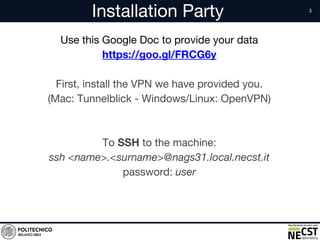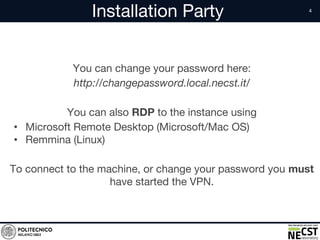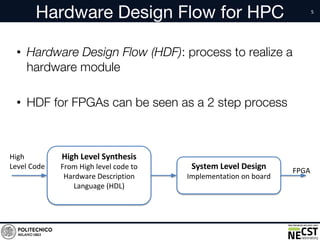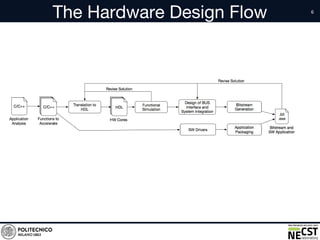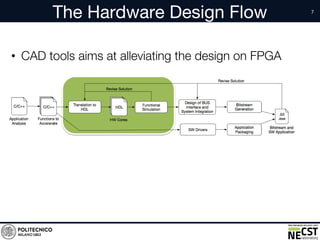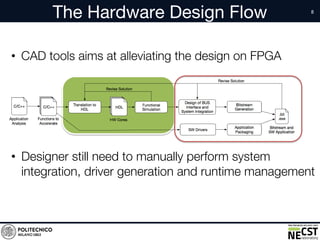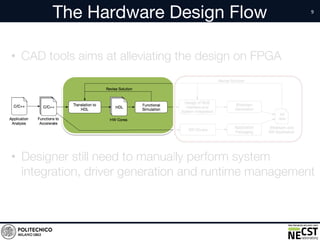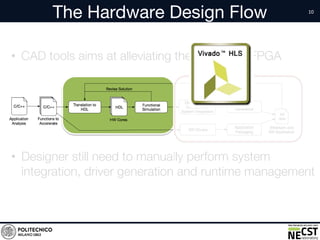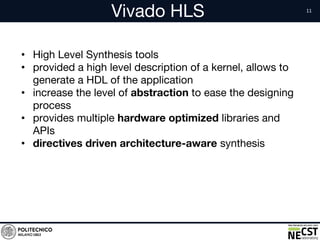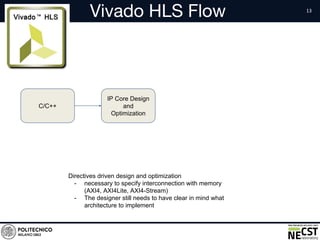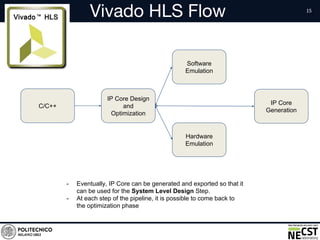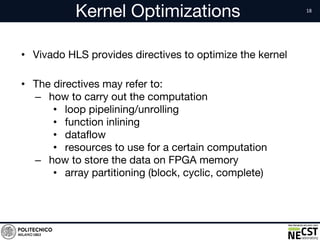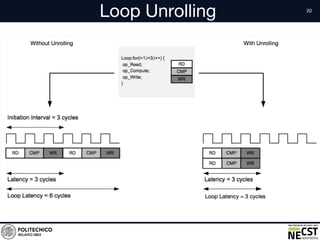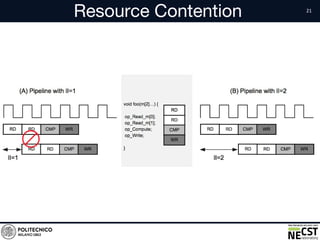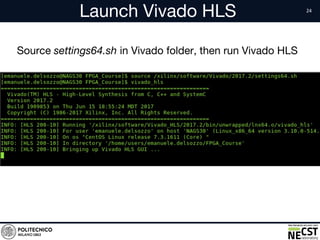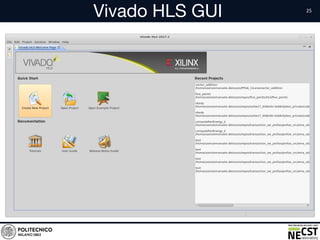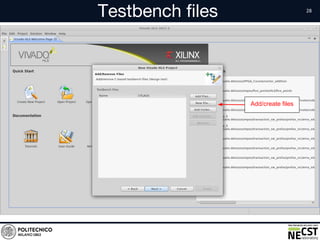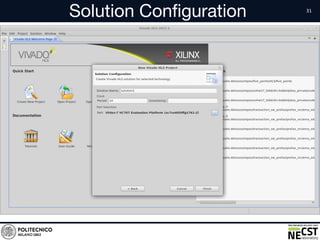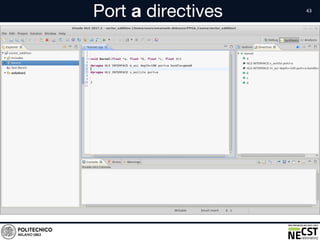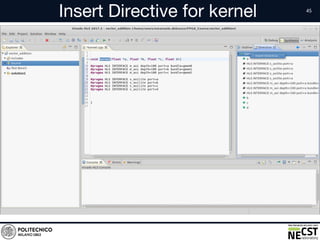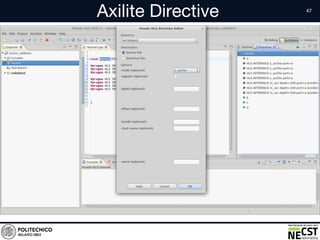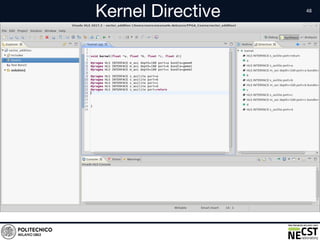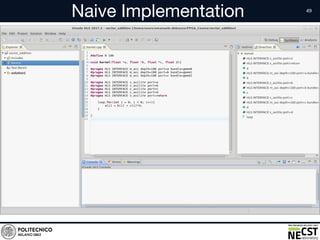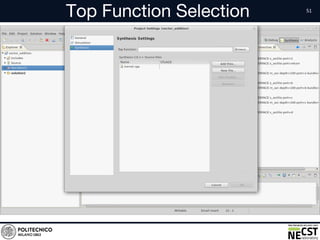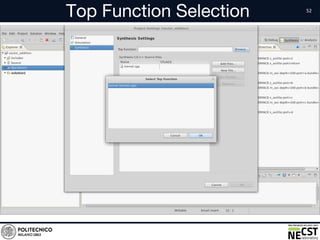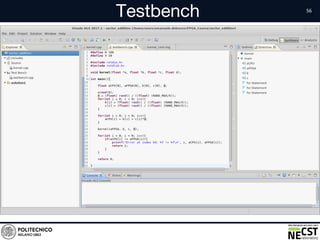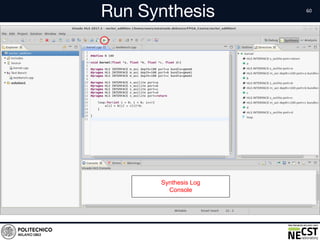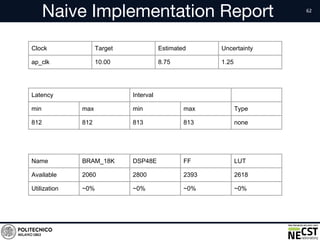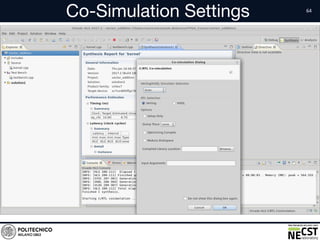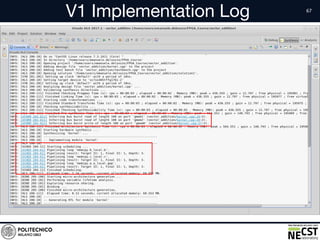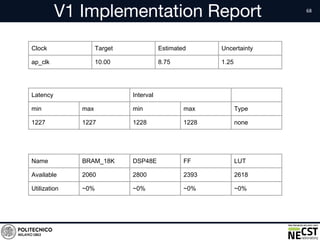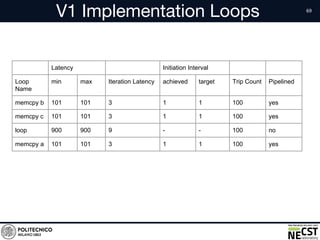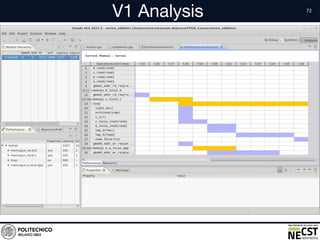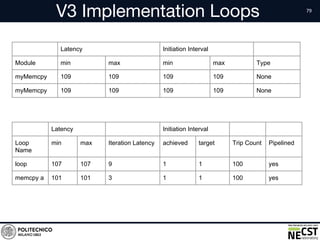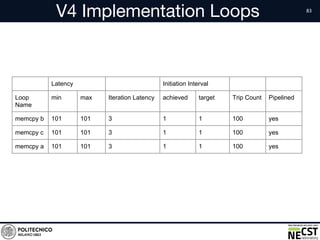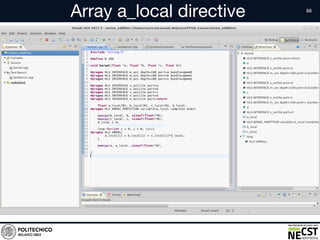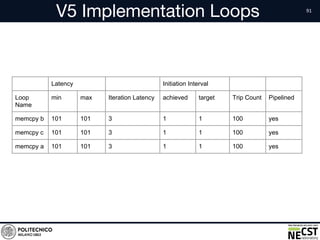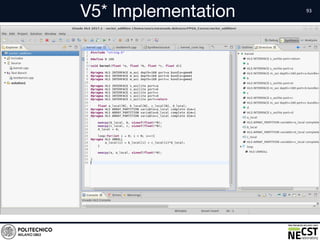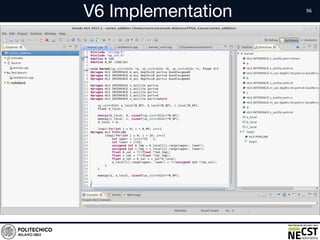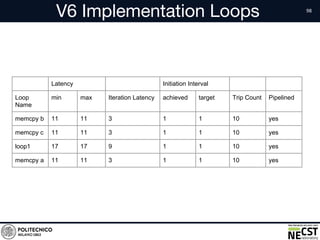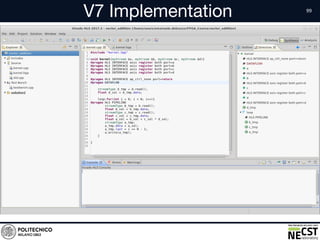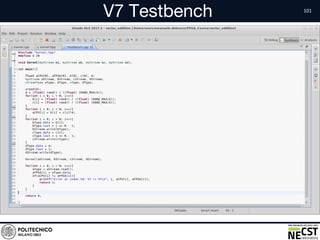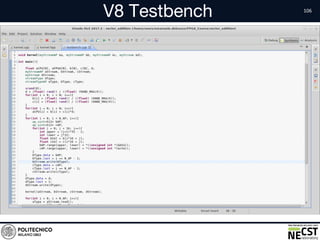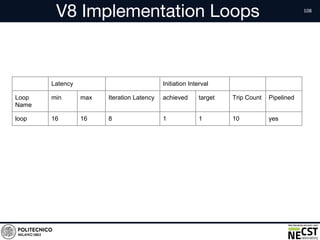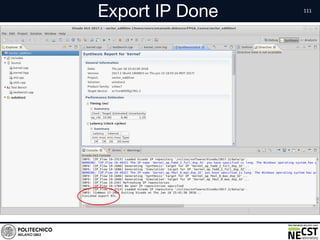SDAccel Design Contest: Vivado HLS
- 1. Courses @ NECST Lorenzo Di Tucci <lorenzo.ditucci@polimi.it> Emanuele Del Sozzo <emanuele.delsozzo@polimi.it> Marco D. Santambrogio <marco.santambrogio@polimi.it> Xilinx Vivado HLS 18/01/2018
- 2. Agenda • Introduction to the Hardware Design Flow • Vivado HLS: –Design Flow –Kernel Creation –Communication Infrastructure –Kernel Optimizations • Hands-On Example
- 3. Installation Party Use this Google Doc to provide your data https://goo.gl/FRCG6y First, install the VPN we have provided you. (Mac: Tunnelblick - Windows/Linux: OpenVPN) To SSH to the machine: ssh <name>.<surname>@nags31.local.necst.it password: user
- 4. Installation Party You can change your password here: http://changepassword.local.necst.it/ You can also RDP to the instance using • Microsoft Remote Desktop (Microsoft/Mac OS) • Remmina (Linux) To connect to the machine, or change your password you must have started the VPN.
- 5. Hardware Design Flow for HPC • Hardware Design Flow (HDF): process to realize a hardware module • HDF for FPGAs can be seen as a 2 step process
- 6. The Hardware Design Flow
- 7. The Hardware Design Flow • CAD tools aims at alleviating the design on FPGA
- 8. The Hardware Design Flow • CAD tools aims at alleviating the design on FPGA • Designer still need to manually perform system integration, driver generation and runtime management
- 9. The Hardware Design Flow • CAD tools aims at alleviating the design on FPGA • Designer still need to manually perform system integration, driver generation and runtime management
- 10. The Hardware Design Flow • CAD tools aims at alleviating the design on FPGA • Designer still need to manually perform system integration, driver generation and runtime management
- 11. Vivado HLS • High Level Synthesis tools • provided a high level description of a kernel, allows to generate a HDL of the application • increase the level of abstraction to ease the designing process • provides multiple hardware optimized libraries and APIs • directives driven architecture-aware synthesis
- 12. Vivado HLS Flow Possibility to specify the kernel using High Level Code - code must be refactored as a subset of C/C++ is supported - no dynamic memory allocation - Multiple API provided (arbitrary precision, mathematical functions, video library, etc..) - Possibility to specify a constraint file (clock uncertainty, clock period, target board) C/C++
- 13. Vivado HLS Flow Directives driven design and optimization - necessary to specify interconnection with memory (AXI4, AXI4Lite, AXI4-Stream) - The designer still needs to have clear in mind what architecture to implement C/C++ IP Core Design and Optimization
- 14. Vivado HLS Flow 2 levels of emulation - Software Emulation used to check functional correctness of the application - does not guarantee correctness on the FPGA - Hardware Emulation check the correctness of the logic generated by the synthesizer C/C++ IP Core Design and Optimization Software Emulation Hardware Emulation
- 15. Vivado HLS Flow C/C++ - Eventually, IP Core can be generated and exported so that it can be used for the System Level Design Step. - At each step of the pipeline, it is possible to come back to the optimization phase IP Core Design and Optimization Software Emulation Hardware Emulation IP Core Generation
- 16. Kernel Creation • Not all the parts of an algorithm are suitable for hardware acceleration • First, it is necessary to profile the application to identify the bottlenecks of the application, i.e. the most compute intensive parts/kernels • Then, it is possible to start adapting and optimizing the kernels for the High Level Synthesis process – define the communication infrastructure – build the kernel architecture
- 17. Communication Infrastructure • Mainly, 3 types of communication may be implemented using AXI4 protocol: – AXI-Lite (for control signals) – Axi-Stream (to stream data) – Axi-Master (direct connection with the memory) • Vivado HLS provides directives to specify which type of communication to implement • However, the user has to develop the data transfer in an efficient way
- 18. Kernel Optimizations • Vivado HLS provides directives to optimize the kernel • The directives may refer to: – how to carry out the computation • loop pipelining/unrolling • function inlining • dataflow • resources to use for a certain computation – how to store the data on FPGA memory • array partitioning (block, cyclic, complete)
- 23. Example • Now we are going to see how to implement a vector addition of this form: a = b + c*d where a, b, c are vectors, and d is a constant • We will go through all optimization steps with Vivado HLS, from the project creation to the IP core generation
- 24. Launch Vivado HLS Source settings64.sh in Vivado folder, then run Vivado HLS
- 25. Vivado HLS GUI
- 27. Kernel files • Text Add/create files Top Function Selection
- 28. Testbench files • Text Add/create files
- 29. Solution Configuration • Text Clock period Part selection
- 32. Editor Interface • Text Project Files Files Editor Outline / Directive Vivado HLS Console
- 33. Editor Interface • Text Project Settings Solution Settings Run C Simulation Run Synthesis
- 37. Kernel function • Text Let’s add the directives for the communication interfaces
- 39. Insert Directive for port a • Text
- 40. Master Axi Directive • Text
- 41. Insert Directive for port a • Text
- 43. Port a directives • Text
- 44. Ports directives • Text Only axilite for port d We pass it as a control signal
- 45. Insert Directive for kernel • Text
- 51. Top Function Selection • Text
- 52. Top Function Selection • Text
- 53. Top Function Selection • Text
- 56. Testbench • Text
- 57. Run C Simulation • Text
- 58. C Simulation Settings • Text
- 59. C Simulation Result • Text
- 60. Run Synthesis • Text Synthesis Log Console
- 62. Naive Implementation Report Clock Target Estimated Uncertainty ap_clk 10.00 8.75 1.25 Latency Interval min max min max Type 812 812 813 813 none Name BRAM_18K DSP48E FF LUT Available 2060 2800 2393 2618 Utilization ~0% ~0% ~0% ~0%
- 67. V1 Implementation Log • Text
- 68. V1 Implementation Report Clock Target Estimated Uncertainty ap_clk 10.00 8.75 1.25 Latency Interval min max min max Type 1227 1227 1228 1228 none Name BRAM_18K DSP48E FF LUT Available 2060 2800 2393 2618 Utilization ~0% ~0% ~0% ~0%
- 69. V1 Implementation Loops Latency Initiation Interval Loop Name min max Iteration Latency achieved target Trip Count Pipelined memcpy b 101 101 3 1 1 100 yes memcpy c 101 101 3 1 1 100 yes loop 900 900 9 - - 100 no memcpy a 101 101 3 1 1 100 yes
- 74. V2 Implementation Log • Text
- 75. V2 Implementation Report Clock Target Estimated Uncertainty ap_clk 10.00 8.75 1.25 Latency Interval min max min max Type 435 435 436 436 none Name BRAM_18K DSP48E FF LUT Available 2060 2800 2393 2618 Utilization ~0% ~0% ~0% ~0%
- 76. V2 Implementation Loops Latency Initiation Interval Loop Name min max Iteration Latency achieved target Trip Count Pipelined memcpy b 101 101 3 1 1 100 yes memcpy c 101 101 3 1 1 100 yes loop 107 107 9 1 1 100 yes memcpy a 101 101 3 1 1 100 yes
- 78. V3 Implementation Report Clock Target Estimated Uncertainty ap_clk 10.00 8.75 1.25 Latency Interval min max min max Type 326 326 327 327 none Name BRAM_18K DSP48E FF LUT Available 2060 2800 2393 2618 Utilization ~0% ~0% ~0% ~0%
- 79. V3 Implementation Loops Latency Initiation Interval Loop Name min max Iteration Latency achieved target Trip Count Pipelined loop 107 107 9 1 1 100 yes memcpy a 101 101 3 1 1 100 yes Latency Initiation Interval Module min max min max Type myMemcpy 109 109 109 109 None myMemcpy 109 109 109 109 None
- 80. V3 Implementation Analysis • Text However, our board has only one physical memory port, hence it cannot physically transfer data in parallel
- 82. V4 Implementation Report Clock Target Estimated Uncertainty ap_clk 10.00 8.75 1.25 Latency Interval min max min max Type 373 373 374 374 none Name BRAM_18K DSP48E FF LUT Available 2060 2800 2393 2618 Utilization ~0% ~0% ~0% 1%
- 83. V4 Implementation Loops Latency Initiation Interval Loop Name min max Iteration Latency achieved target Trip Count Pipelined memcpy b 101 101 3 1 1 100 yes memcpy c 101 101 3 1 1 100 yes memcpy a 101 101 3 1 1 100 yes
- 84. V4 Implementation Analysis • Text
- 85. Insert Directive for a_local • Text
- 87. Array Partition Directive • Text
- 88. Array a_local directive • Text
- 90. V5 Implementation Report Clock Target Estimated Uncertainty ap_clk 10.00 8.75 1.25 Latency Interval min max min max Type 320 320 321 321 none Name BRAM_18K DSP48E FF LUT Available 2060 2800 2393 2618 Utilization ~0% 17% 8% 12%
- 91. V5 Implementation Loops Latency Initiation Interval Loop Name min max Iteration Latency achieved target Trip Count Pipelined memcpy b 101 101 3 1 1 100 yes memcpy c 101 101 3 1 1 100 yes memcpy a 101 101 3 1 1 100 yes
- 92. V5 Implementation Analysis • Text
- 94. V5* Implementation Report Clock Target Estimated Uncertainty ap_clk 10.00 8.75 1.25 Latency Interval min max min max Type 508 508 509 509 none Name BRAM_18K DSP48E FF LUT Available 2060 2800 2393 2618 Utilization ~0% 28% 13% 19%
- 95. V5* Implementation Loops Latency Initiation Interval Loop Name min max Iteration Latency achieved target Trip Count Pipelined memcpy b 160 160 2 1 1 100 yes memcpy c 160 160 2 1 1 100 yes memcpy a 160 160 2 1 1 100 yes
- 97. V6 Implementation Report Clock Target Estimated Uncertainty ap_clk 10.00 8.75 1.25 Latency Interval min max min max Type 75 75 76 76 none Name BRAM_18K DSP48E FF LUT Available 2060 2800 2393 2618 Utilization 6% 2% 2% 3%
- 98. V6 Implementation Loops Latency Initiation Interval Loop Name min max Iteration Latency achieved target Trip Count Pipelined memcpy b 11 11 3 1 1 10 yes memcpy c 11 11 3 1 1 10 yes loop1 17 17 9 1 1 10 yes memcpy a 11 11 3 1 1 10 yes
- 101. V7 Testbench • Text
- 102. V7 Implementation Report Clock Target Estimated Uncertainty ap_clk 10.00 8.46 1.25 Latency Interval min max min max Type 169 169 170 170 none Name BRAM_18K DSP48E FF LUT Available 2060 2800 2393 2618 Utilization 0% ~0% ~0% ~0%
- 103. V7 Implementation Loops Latency Initiation Interval Loop Name min max Iteration Latency achieved target Trip Count Pipelined loop 166 166 8 1 1 160 yes
- 105. V8 Streaming Interface • Text
- 106. V8 Testbench • Text
- 107. V8 Implementation Report Clock Target Estimated Uncertainty ap_clk 10.00 8.46 1.25 Latency Interval min max min max Type 19 19 20 20 none Name BRAM_18K DSP48E FF LUT Available 2060 2800 2393 2618 Utilization 0% 2% 1% 1%
- 108. V8 Implementation Loops Latency Initiation Interval Loop Name min max Iteration Latency achieved target Trip Count Pipelined loop 16 16 8 1 1 10 yes
- 109. Export IP
- 110. Export IP Settings
- 111. Export IP Done
- 112. This is only the beginning!! For more information, read Vivado HLS manual https://www.xilinx.com/support/documentation/sw_ma nuals/xilinx2017_2/ug902-vivado-high-level-synthesis.pdf
- 113. Feedbacks • We are working at improving this course, would you share your feedback for this lesson? https://goo.gl/tLcWQj
- 114. Thank You for the Attention! Lorenzo Di Tucci lorenzo.ditucci@polimi.it Emanuele Del Sozzo emanuele.delsozzo@polimi.it Marco D. Santambrogio marco.santambrogio@polimi.it


